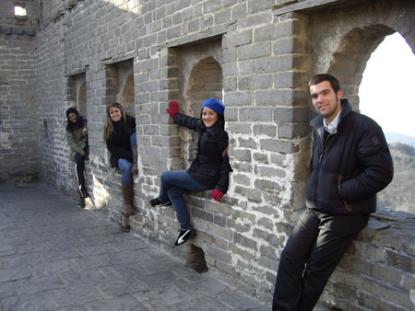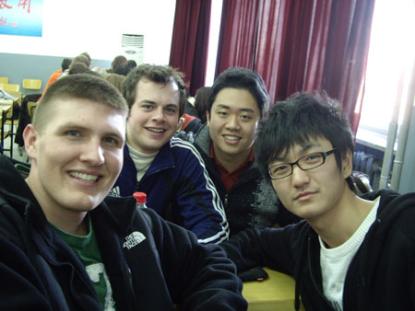
After spending some time in Beijing, I have quickly realized that China is not the same country as the one shown in the media and news publications in the United States,” said Tom Lill, then a second year college student who traveled to China in January 2009, “I now view both Beijing and China in a much more positive light and wish everyone could see this incredible country as it opens up to the world.”
Tom is only one of the increasing number of U.S. students who travel and study in other countries. According to the Institute of International Education, 241,791 U.S students studied abroad for academic credit in 2006-07, an increase of 8.2% over the previous year. However, the number only accounts for less than 2% of total U.S. college student enrollment.
The impact of travel and study abroad on learning a foreign language and understanding a different culture can never be overstated.
For language students, immersing themselves into the foreign language environment provides them an excellent opportunity to learn and use the language immediately in real-life situation. In many situations, they are somewhat “forced” to learn the language quickly in order to survive and function, for example how to order from a menu or find a specific location.
Almost all language students share this experience: the minute they arrive in another country, they suddenly realize that what people actually say there is different from what they learned in the textbooks back in the U.S. This is common because as languages have variations over time and in different regions, gaps and disconnections between textbooks and the real language are always expected. There’s no better way to close this gap by being there immersed into the language environment.
English is my second language. When I first came to the U.S., I rarely heard people say “how do you do?” which was the standard greeting I learned in English textbooks in China. Then I discovered there were so many phrases and expressions that were different from what I learned. That was obviously frustrating, but at the same time exciting, because I knew the English I began to learn here was what people are using everyday. After all, it’s all about communicating freely and appropriately with people in another language.
Travel and study abroad experience motivates students to learn another language in many ways. They are pleasantly surprised when they realize how much they can improve their language skills in a relatively short period and how much they can exchange information and ideas with local people. Even for students who haven’t studied abroad, the idea of communicating in another language with people in a different culture is intriguing. Then it won’t be long before they realize that their bilingual or multilingual skills can actually enhance their future career opportunities and even lead to a new career. It is estimated that one out of six jobs in the U.S. is tied to international trade.
Travel and study abroad not only provides an excellent language learning opportunity, but more importantly, a first-hand experience to learn and understand a different culture, an experience that can never be substituted by textbooks, news and media.
Although we are in the 21st century and a global information age, ignorance and stereotypes of other cultures are still prevalent and often prejudices against other cultures and countries are spreading more widely with the advanced technology. The media and popular culture keeps making the situation worse by perpetuating many of the stereotypes and prejudices. For the new generation of students who don’t have enough media literacy and global education, they are entering the global economy and job market with misunderstandings and misconceptions of other countries and cultures. It can be as dangerous as one can imagine.
But for students who have travel and study abroad experience, the difference is clear.
“My viewpoint of China has changed drastically,” one student said after returning from a two-week study trip from China I led in January 2009, “from watching all of the happy families gathering together during the Chinese New Year, and seeing the huge and proud monuments that so many Chinese pay homage to, I really feel like I can say that things are not the way they seem from across the pond.
A simple example of this is that personally before I toured China I viewed the color red as a sign of communist oppression and blood shed, much like how we associate the color red in our flag with the bloodshed by others for our freedom. But getting on the plane ride home the color red has an entirely different meaning and I am embarrassed to admit to my original notion. Happiness is what Chinese red truly stands for. It is seen in the cards filled with money that are passed around as gifts, and it adorns the walls of the buildings we visited. This is a very happy place.”
Personally I’m not sure whether it is possible for a student to develop a similar understanding without experiencing the culture in person. In addition to the cultural understanding, this student’s experience demonstrates a classic example of developing critical thinking skills and a global perspective.
The study abroad experience can be both eye-opening and life-changing. For many students, for the first time in their life, they become a minority of the society and things that used to be familiar to them are different and sometimes difficult. Finally they learn how to think about issues from different angles and perspectives. They become bicultural or even multicultural.
After all, in today’s world, learning other languages and cultures is no longer a luxury, but a necessity. It is true everywhere, especially in the U.S.



